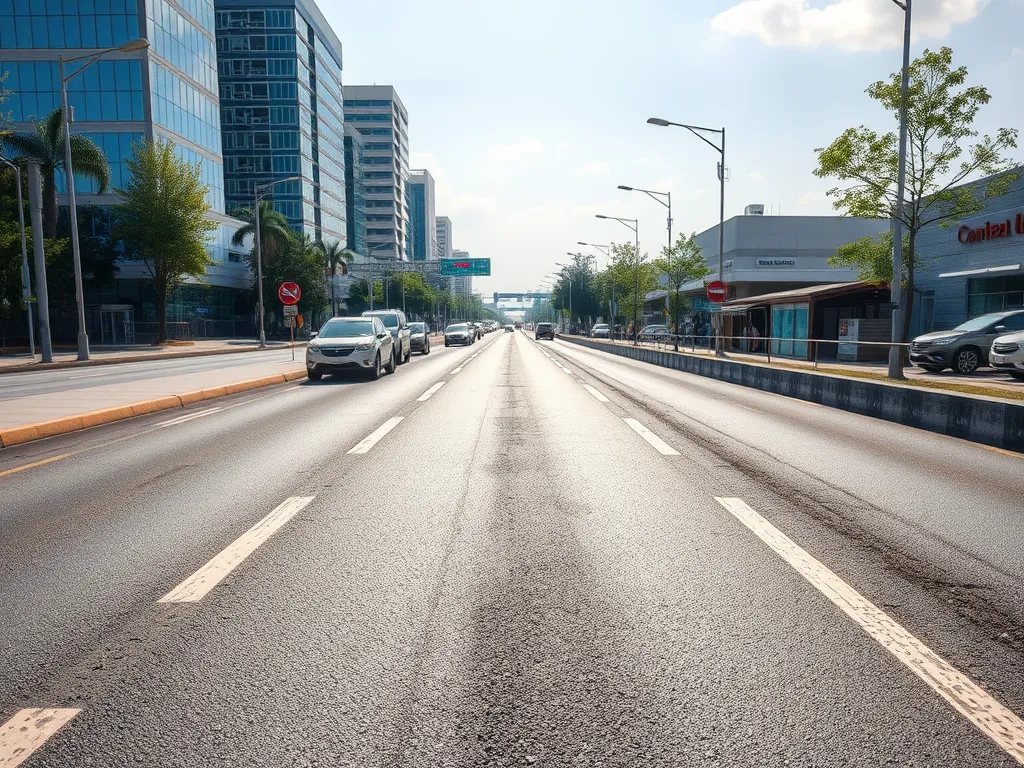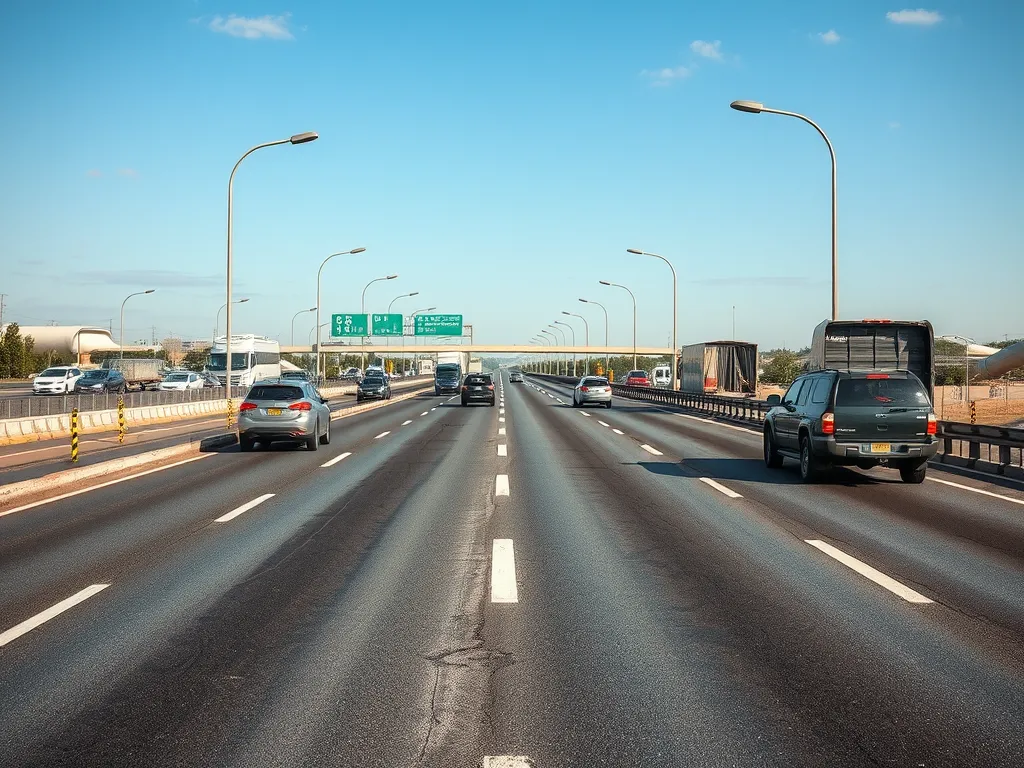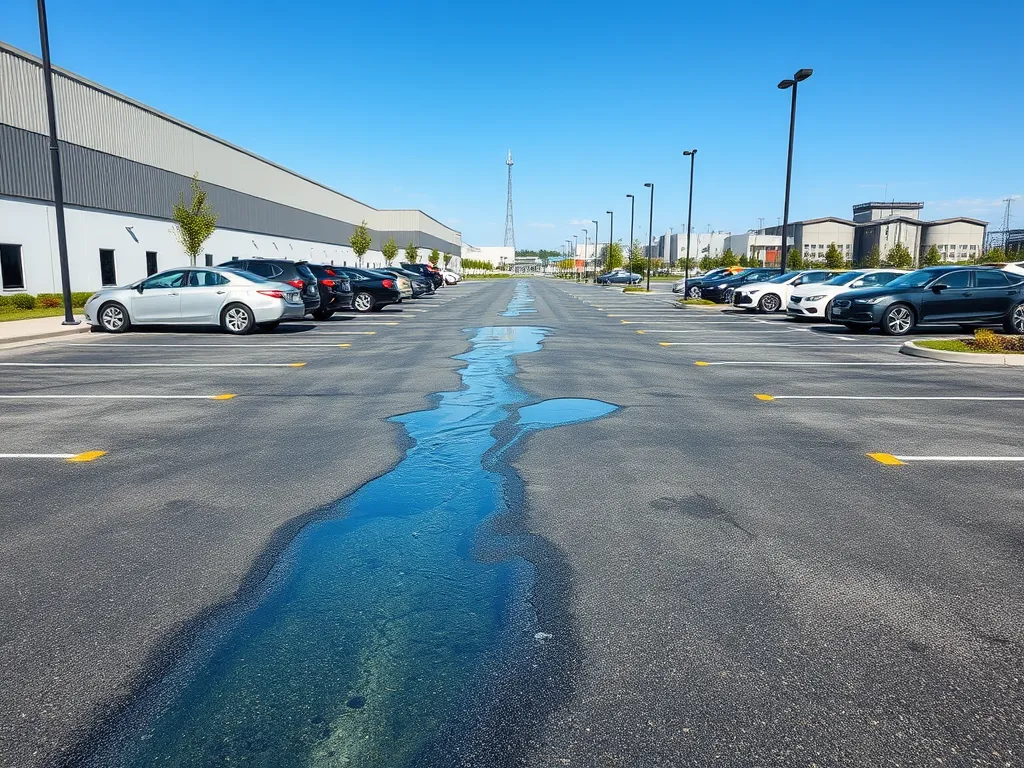Common Uses for Asphalt in Residential and Commercial Settings
Published on: October 22, 2025 | Last Updated: April 14, 2025
Written By: George Voss
Asphalt creates durable surfaces for homes and businesses, serving driveways, parking areas, and roadways. Made from stone aggregates bound with bitumen (a petroleum-based binder), residential projects typically use 2-3 inch layers with PG 58-28 binders, while commercial surfaces require 4+ inches and polymer-modified mixes for heavy trucks. This adaptability makes asphalt America’s top paving choice, used on 94% of paved roads.
This guide breaks down asphalt’s versatility across settings. Compare residential driveway designs to commercial parking lot specifications. Learn how airport runways use specialized hot mix asphalt (HMA), while permeable pavements manage stormwater. We’ll explore thickness requirements, material blends like Superpave mixes (engineered for climate-specific performance), and cost-saving recycled asphalt (RAP) that reduces project expenses by 25-30%.
Contents
Key Residential Asphalt Applications
Asphalt serves as the backbone for durable home surfaces. Homeowners pick it for its blend of strength and style. From driveways to pool decks, it adapts to daily life demands.
Asphalt Driveways: Design and Durability
Over 90% of U.S. driveways use asphalt. Its smooth finish resists cracks in freeze-thaw cycles. PG 64-22 binders boost cold-weather performance.
Advantages of Asphalt Driveway Installation
New asphalt driveways cure in 48 hours. They handle 8,000+ lbs per tire load. Dark tones hide oil stains better than concrete. Costs range $3-$5 per square foot installed.
Cost-Effective Maintenance Strategies
Sealcoating every 3 years adds 5+ years of life. Crack fillers under $0.50 per linear foot prevent water damage. Infrared patching fixes potholes in 20 minutes flat.
Home Parking Solutions
Asphalt beats gravel for dust control in home parking zones. It withstands daily car traffic without rutting. Proper crowning sheds water at 2% slope minimum.
Customizable Residential Parking Layouts
Stamped borders or colored topcoats mark RV bays. Permeable mixes allow 500+ inches of rain per hour drainage. 3-inch bases support fire truck access during emergencies.
Specialty Residential Uses
Beyond driveways, asphalt shapes backyard living spaces. Its non-slip texture meets ADA standards when textured. Heat-reflective coatings cut surface temps by 30°F.
Asphalt for Garden Pathways and Pool Decks
2-inch thick paths blend with landscape designs. Pool decks use fine-graded HMAs for barefoot safety. UV-resistant sealers prevent fading near chlorine splash zones.
While homes benefit from asphalt’s flexibility, commercial sites need heavier-duty solutions. Next, we’ll break down how airports and shopping centers push asphalt performance to new limits.
Essential Commercial Asphalt Uses
Asphalt dominates commercial projects due to its rapid installation and ability to handle extreme loads. From mega-stores to transport hubs, this material meets rigorous demands while keeping costs manageable.
High-traffic Commercial Parking Lots
Big-box retailers and shopping centers rely on asphalt paving for lots that endure 500+ daily vehicle movements. Properly designed lots last 15-20 years with routine sealcoating every 3-5 years. Costs average $2.50-$4.00 per square foot installed.
Best Asphalt Mixes for Heavy Vehicles
Parking areas with delivery trucks or RVs need PG 76-28 binder grades and 1.5-2.5 inch aggregate sizes. These Superpave mixes compact to 95% density, resisting rutting under loads exceeding 10,000 lbs per axle. Additives like gilsonite boost stiffness by 40%.
Industrial Asphalt Infrastructure
Beyond retail, asphalt supports operations at factories, ports, and logistics hubs. Specifiers prioritize high-stability mixes and advanced drainage designs for these heavy-duty applications.
Airport Runways and Loading Docks
Boeing 737s demand runways with 18-24 inch asphalt bases using polymer-modified binders. Loading docks use 6-8 inch layers with 9.5mm NMAS stone matrix asphalt to prevent tire marks. Both require 3% cross-slopes for water runoff.
Commercial Roadway Construction
Urban arterials carrying 30,000+ daily vehicles use perpetual pavement designs with three asphalt layers: a fatigue-resistant base, durable middle course, and rut-proof surface. Open-graded friction courses reduce hydroplaning risks by 60% compared to concrete.
While commercial specs focus on max load tolerance, residential projects prioritize curb appeal. Next, we’ll break down how thickness and material choices differ between these two sectors.

Comparing Residential Vs Commercial Asphalt
Residential and commercial asphalt serve distinct roles. Their design specs change based on traffic, weight loads, and lifespan needs. Let’s break down key technical splits.
Thickness and Load Requirements
Home driveways use 2-3 inch layers. This handles cars (1-2 tons) and resists cracks from freeze-thaw cycles. Commercial lots need 3-4 inch base plus 1.5-2 inch top. This supports trucks (up to 40 tons) with PSI ratings over 300. Airport runways go thicker—12-18 inches—for plane loads.
Material Composition Differences
Residential mixes favor PG 64-22 binders. These flex in cold temps (-22°F) but soften less in summer heat (64°C). Commercial jobs need PG 76-22 for high heat rut resistance. Aggregates differ too: homes use ½” stone for smooth drives; lots use ¾” stone for heavy wear. Recycled asphalt (RAP) rates vary—20% max in homes, 30% in commercial jobs.
These factors shape why asphalt paving works for both driveways and roadways. Up next: how mix science adapts to unique build sites.
Also See: Asphalt Vs Concrete Vs Gravel: Which is Best?
Asphalt in Construction Projects
Asphalt serves key roles in building work beyond roads and lots. Builders use it to seal and shield structures from harm.
Foundation Waterproofing Solutions
Asphalt blocks water from seeping into base layers. It forms a tight shield under slabs or walls. This stops leaks in cellars and crawl spaces.
Asphalt Roofing Membranes
Flat roofs use asphalt sheets to block rain. These rolls have fiberglass or fabric in sticky bitumen. They last 15-30 years with few fixes. Brands like GAF and Owens Corning make these for stores, schools, and homes.
Road Construction Specifications
Road builds need precise asphalt mixes. These blends must handle weight, weather, and wear over time.
Hot Mix Asphalt for Highways
Hot mix asphalt (HMA) forms strong road layers. Made with stone, sand, and thick bitumen. Used for highways that handle 3,000+ cars per day. HMA lasts 10-15 years with proper care.
Porous Asphalt for Drainage
Porous asphalt lets rain soak through the surface. Gravel beds under the pave store water. This cuts flood risks in lots and drives. Each square foot can drain 5-7 gallons per hour.
From roofs to roads, asphalt solves core build needs. Next, we break down how raw bits become pave mix.

Asphalt Production and Material Science
Asphalt’s adaptability in both housing and business projects starts at production facilities. Mix design and material science directly impact how paving performs under cars, trucks, or foot traffic.
Manufacturing Process Overview
Hot mix asphalt (HMA) forms at 300°F–350°F in drum plants or batch facilities. Aggregates—crushed stone, sand, gravel—blend with liquid bitumen. This creates a workable material that cools to a solid surface. Modern plants add up to 30% recycled asphalt pavement (RAP), cutting costs without losing strength for driveways or parking areas.
Grade Variations and Performance
Performance-graded (PG) binders dictate asphalt quality. PG 64-22 works for most housing drives, handling four-season weather. Commercial lots needing heavy truck support require PG 76-28 or polymer-modified mixes. Superpave specifications govern aggregate shape and size, ensuring optimal compaction. A 4-inch residential driveway might use ½” stone matrix, while airport runways demand 1” top layers with fiber additives.
Modern mix designs now allow porous asphalt installations. This variant has 16%–20% void spaces, draining 5 gallons of water per square foot hourly—ideal for parking areas with stormwater rules.
Up next: How these material advancements support sustainable building practices.
Environmental Considerations
Modern asphalt projects balance functionality with ecological responsibility. Two approaches dominate sustainable paving: recycled materials and permeable designs.
Recycled Asphalt Applications
Recycled Asphalt Pavement (RAP) mixes 95% reclaimed material with fresh binders. Contractors use RAP for:
- Driveway resurfacing: 30-50% RAP blends lower asphalt paving residential costs by $3-$7 per square foot
- Commercial parking lots: High-grade RAP withstands heavy traffic while reducing landfill waste
- Road base layers: Crushed RAP stabilizes foundations for asphalt roadways and runways
Federal Highway Administration data shows RAP cuts energy use by 20% versus virgin mixes. Many states mandate 15-30% recycled content in public projects.
Permeable Pavement Solutions
Permeable asphalt features 14-20% void space for water infiltration. This porous design:
- Reduces stormwater runoff by 50-70% in residential driveways
- Prevents flooding in commercial lots (handles 7-12 inches of rain/hour)
- Filters pollutants through aggregate layers below the surface
Maryland’s permeable asphalt parking lots demonstrate 90%+ permeability after 15 years. Installations require 18-inch crushed stone bases for optimal drainage.
These innovations address environmental concerns while maintaining asphalt’s structural benefits. Next, we’ll answer frequent queries about material selection and performance.

Asphalt Usage FAQs
What Are the Benefits Of Using Permeable Asphalt in Residential Projects?
Permeable asphalt allows for effective stormwater management by enabling rainwater to drain through the surface, reducing runoff and potential flooding. This is especially beneficial in areas prone to heavy rainfall, making it an environmentally friendly choice for homeowners.
How Often Should I Seal My Asphalt Surfaces?
It is recommended to sealcoat residential asphalt surfaces every 3 to 5 years to prolong their lifespan and maintain their appearance. Regular maintenance helps protect against the elements, such as UV rays and water damage, which can lead to cracks and deterioration.
Can Recycled Asphalt Be Used in Residential Projects?
Yes, recycled asphalt can be a cost-effective and sustainable option for residential projects. Blending 30-50% recycled material in new asphalt contributes to lower installation costs while still providing a durable surface for driveways and pathways.
What Type Of Asphalt is Best for High-traffic Commercial Areas?
For high-traffic commercial areas, asphalt mixes containing polymer-modified binders, such as PG 76-28, are ideal as they provide enhanced durability and resistance to rutting. These mixes are especially effective in parking lots with heavy vehicle usage.
How Does Climate Affect Asphalt Performance?
Climate plays a significant role in asphalt performance. Warmer climates may require asphalt with high heat resistance, while cold climates benefit from flexible mixes that can withstand freezing and thawing cycles. Selecting the appropriate grade and mix is crucial for durability in varying weather conditions.
What is the Difference Between Hot Mix and Cold Mix Asphalt?
Hot mix asphalt (HMA) is produced at high temperatures and is ideal for permanent paving solutions due to its durability and strength. Cold mix asphalt, however, is versatile and can be used for temporary patching and repairs, as it does not require heating for application.
Is Asphalt Environmentally Friendly?
Asphalt can be considered environmentally friendly when using recycled materials, such as Recycled Asphalt Pavement (RAP), which reduces waste in landfills and lowers energy consumption during production. Additionally, permeable asphalt solutions help manage stormwater and reduce environmental impact.
What Are Some Aesthetic Options Available With Asphalt?
Asphalt surfaces can be enhanced with various aesthetic options, including colored sealers, stamped designs, and decorative borders. These options allow homeowners and businesses to customize their asphalt surfaces while maintaining durability and functionality.
Final Summary
Asphalt stands out as a versatile material for both residential and commercial applications. From durable driveways and efficient parking solutions to high-traffic commercial lots and robust airport runways, its uses are diverse. For homeowners, asphalt offers a sustainable option that combines aesthetic appeal with long-lasting performance. For businesses, it ensures safety and accessibility, particularly in high-capacity environments.
Different thicknesses and material compositions cater to unique needs, ensuring that asphalt serves effectively in varying contexts. Additionally, its role in construction projects, such as foundation waterproofing and road construction, underscores its broad applicability in modern infrastructure.
Investing in asphalt not only provides a cost-effective solution but also contributes to environmental sustainability through recyclability and permeable options. For more information, visit Asphalt Calculator USA.
Useful References for You:
- National Asphalt Pavement Association (NAPA, Industry Reports & Best Practices)
- Main Uses of Asphalt | Common Uses of Asphalt | Asphalt Applications
- The Many Uses of Asphalt: A Complete List – PALERMO PAVING
- Asphalt | Components, Development, Properties, & Facts | Britannica
- An Essential Guide To Asphalt


